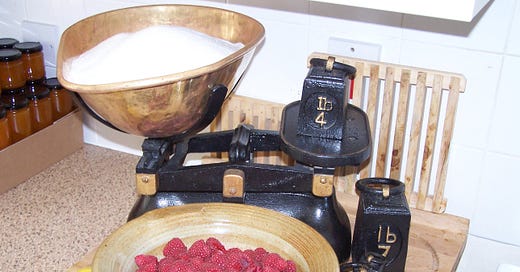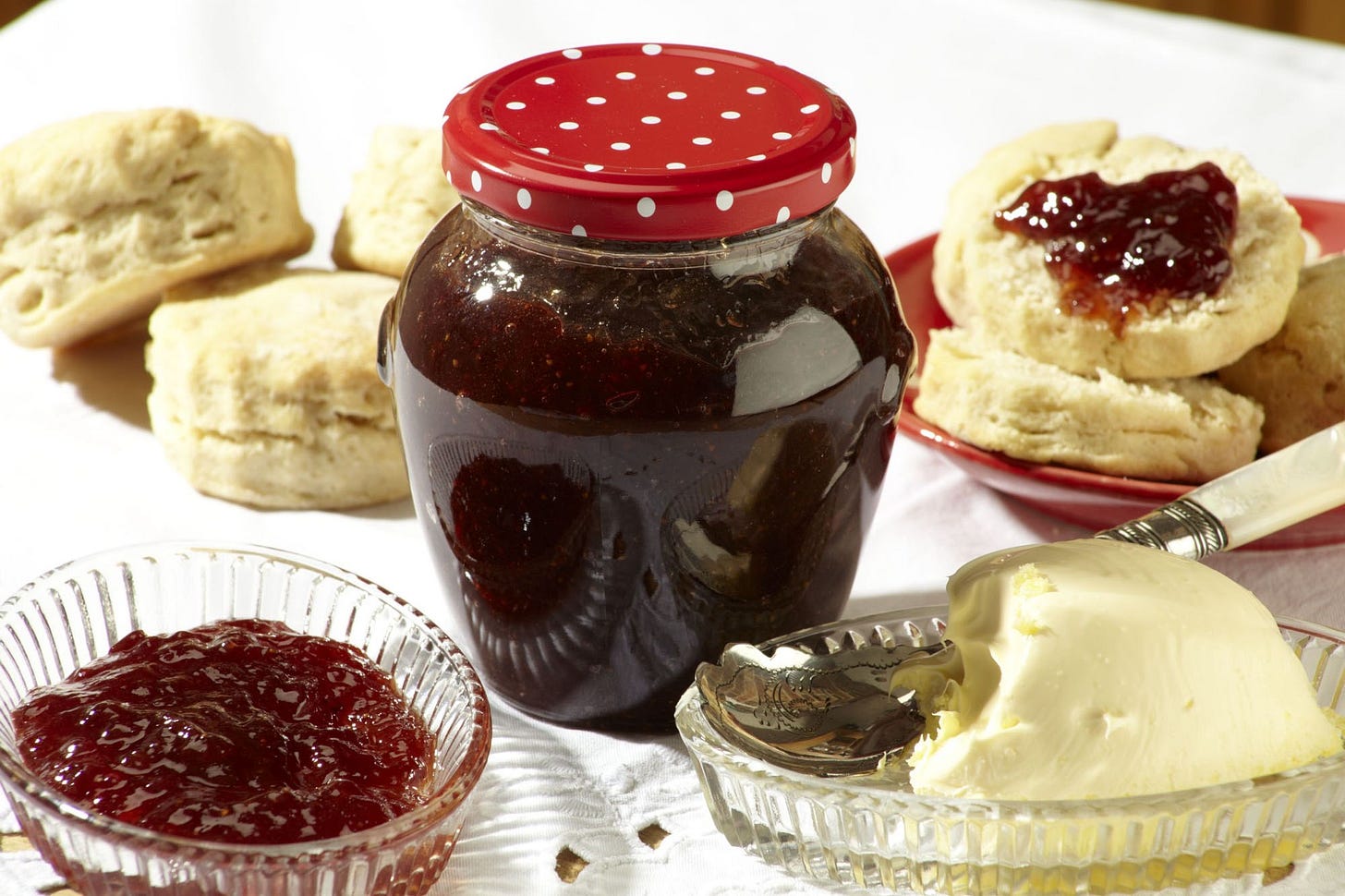I am not going to tell you that I never eat Ultra Processed Food. Sometimes there is no alternative, but if and when I do, I do it conciously in the full understanding of what is at stake. I know I am eating it - sometimes I even enjoy it ( Magnum ice-creams! ) and if, when I have eaten it I feel that I could eat another one I absolutely do not because that is the point of UPF. To make you love it, to make you eat more than you would of the equivalent non-UPF - and then go back for more. It is not the case that home produced food is tasteless or boring, but with UPF you are fighting a battle that you will not win.
Firstly it is ridiculously cheap, it is covered in offers as a rule - BOGOFFs make it economic madness not to buy more than you actually need and when you do feel that you could eat another, there it is, right there. The ingredients are in the main, not actual food, but made to look like food that you recognise. They are very, very cheap making the manufacturing cost negligeable and the special offers a no-brainer. From what I know from sourcing custom made packaging for the products for my business, the boxes will be the most expensive part. My friend’s point of view, after a lifetime of interactions which such companies, you are better off eating the box.
Let’s have a look at another product which has become an everyday item in our lives but which wasn’t around when I was a child, or even a teenager.
Bottled water.
Water is a dynamic compound and many of us have been lucky enough to grow up in a time when there have been plentiful supplies of drinking water, and water in general.
Water is not an element in its own right, as it consists of two elements, oxygen and hydrogen. However, to me it is alive, it needs to flow not be imprisoned. We cannot maintain our own health and lifeforce without regularly consuming fresh water but I think that the pendulum has swung. Somehow we have been persuaded to carry water around with us at all times. We now feel unable to undertake the shortest journey without encumbering ourselves with unwieldy bottles in case we suddenly need a drink. For someone like me who has lived both sides of the watershed as it were, this continues to be bizarre. I find that, unless I am exercising, it is impossible for me to keep drinking from a bottle in the street, on a train, at work or any other place that might present itself. And all of that plastic which we hate so much. I don’t think that I can be alone in this.
I recently watched a short piece of footage about Chelsea Flower Show featuring one of the experts from The Repair Shop, arriving, suited and booted, as a guest of the Committee. He entered early in the day, through the entrance gate, ushered in by a lanyard-wearing CFS Official. He clutched at a rather large size of bottled water rather like a comfort blanket. He was turning it round and round in his hands, repeatedly checking the cap for tightness. As the day wore on the level of water had hardly changed but as it had been carried around for hours, it must have been really warm. Everytime he was introduced to someone and shook hands, it had to be clutched under his arm and as he gathered purchases they had to be accomodated as well. What a faff.
What bothers me more though is how is water capture paid for? Who decides on how much can be taken and what it costs? When many Countries still experience severe droughts how come it is OK to literally imprison millions of litres of a World resource in plastic bottles all over the planet. How long can it be captured for, who has an overview on this? Who decides? The water that was created at the Dawn of Time is still the water that we have available today - more cannot be created, it cannot be destroyed, it can ‘only’ change form. Human beings are around 70% water so the more the population grows the more water needed - unless the death rate keeps pace of course . . . .
There is a lot more to say on this but that leads me to another product that wasn’t a ‘thing’ when I was young. Coca Cola. I will use that term for all fizzy drinks which again were only just becoming readily available via the Corona Man who delivered each week and collected the empties. Coca Cola of course, has grown at an alarming rate and in the UK we now manage to consume a staggering 4900 million litres annually at a cost £798 million. We are seventh in the league tables of European nations in our level of consumption. Sucrose figures in the manufacture of Coca Cola - in the ‘full fat’ - version and, of course, a variety of artificial sweeteners in the low-cal-no-cal types. You already know my take on those. Not to mention all of the water required in the manufacture of just this one product.
So, here we are are. The reason I am writing about this is because I am at a loss in most of the preserving arguments. So many articles I read, posts on facebook and insta, general conversations, squak ‘oh there is so much sugar’ they are asking for low sugar recipes, or zero sugar home baking recipes. In the case of preserving, the sugar, as we have discussed before, is a significant factor in keeping the food actually preserved. Take the sugar out and you will have a fridge full of jars.
Reminder: 4900 million litres annually of coca cola. Four thousand. Nine hundred. million litres.
So when I teach jam making I explain that it is more like a chemistry experiment.
Put jars to warm in a low oven 50-100 degrees
1 Very fresh fruit, some slightly underripe, jam made as soon after picking as possible.
2 Very fresh = highest pectin level - it starts to drop as soon as the fruit leaves the tree so make as soon as possible
3 Equal fruit to sugar - no arguments
4 Acid - juice of one lemon per 1 kilo of fruit
To make: Put the fruit into a large pan no more than one third full. Turn the heat on to low/medium and heat until the juices start to run. Add the lemon juice and stir, cook gently until the fruit is soft and very juicy.
Take off of the heat and pour in the sugar stirring to combine as much as possible. Put back onto the medium heat and stir until the sugar dissolves completely - so you can’t hear it and you can’t feel it.
Turn the heat up high, stop stirring and turn on timer for 6 minutes as soon as there are bubbles across the surface.
After a couple of minutes stir the spoon around once in a figure of eight motion to check for any sticking. Leave the spoon in the pan. After another two minutes, repeat. If you keep stirring the jam will cool down and may spoil. After six minutes take the pan from the heat and put onto a heatproof surface. Spoon a little of the jam onto a cold saucer and put that in the fridge. Start stirring the jam vigourously to disperse any ‘foam’ from the surface without scraping the sides at all.
Check the jam on the saucer with the crinkle test - push the jam with the side of your little finger away from you and look to see if the surface crinkles up. If you are good to go fetch the jars from the oven and ladle the jam in right to the top and put on the lid. Leave without moving them until the next day when you can label and store them. Good for at least a year at ambient temperature storage. ( Actually more like ten years . . .)
.
That is the process, should take 30 minutes max. Delicious jam like you have never tasted and don’t whine to me about the amount of sugar - how much are you eating at once? Eat it and enjoy it for goodness’ sake - literally goodness’ sake
Remember: 4900 million litres annually of coca cola. Four thousand. Nine hundred. million litres. I don’t believe that a population of 69 million Brits who can neck 4900 million litres of sugar-laden water+colouring is terrified of a bit of home-made jam.
Think: Can you recall any occasion when you have drunk a can/bottle of coca cola which has been elevated because of the actual bottle of this drink? Any family gathering that is memorable for its coca cola? Read on.
Now, one of my mantras is ‘ you will always get more out of a jar of a preserve you have made than the ingredients you put into it’ Even this jam I have just taken you through step by step. You will remember where you got the ingredients, you will remember the absolute thrill of opening the jar, tasting the first spoonful of your first jam - nothing like the first time! Sharing with friends or family, feeling excited to know what they think, it will seem like alchemy. You -you, turned those raspberries into ambrosia, just like that.
Escalate. Friends are over for the weekend, a walk along the old disused railway tracks is planned, the weather is sunny and warm, dogs are excited, kids are on bikes and scooters as you wander along chatting and laughing. Someone spots some blackberries along the way which are begging to be picked. A bag is found tucked into the back of the baby stroller and everyone is quickly covered in purple juice!
When you get home the berries are rinsed and picked over for leaves then dumped into your pan and gently cooked to ‘fix’ in the pectin. No time to make jam until friends have departed for home, so the heat is turned off and the pan covered with a clean tea-towel. Next day, the jam is completed and set aside ready for hampers later.
Get the children to make ‘Purple Fingers Jam’ labels and colour them in. Write the memory of the day on a gift tag for your friends to have their own enjoyable recollections of that late Summer day. They won’t worry that it has sugar in it - it has such happy memories it doesn’t matter about anything else and you aren’t going to eat 4900 million jars of it.
Relax. We have been eating sugar for more than 11,000 years and it is self-limiting. We still have teeth, we can still run about.
We have been eating Ultra Processed Food for no more than 40 years and it is killing us.
Resources






I have lots of blackcurrants this year so I’ll make some jam with sugar and we will celebrate this fruit throughout the year.
Great as always! Liked your story about the water bottle
I have now got one of the copper bottles and definitely water tastes different in it, Louise